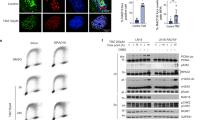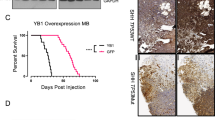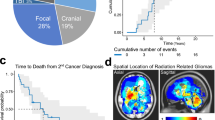Abstract
Glioblastoma is the most frequent primary brain tumor in adults. The average survival time of less than 1 year did not improve notably over the last three decades. The dismal prognosis of glioblastoma patients is largely due to the striking radioresistance of this tumor. Here, we attempt a combined view on the genetics, the repair mechanisms and the radioresistance of glioblastoma. Specifically, we address the role of DNA-PKcs and the novel potential end-joining factor KUB3 in maintaining the radioresistant phenotype, the interrelationship between genetic lesions and repair mechanisms, and new perspectives that emerge from the identification of glioblastoma stem cells.
This is a preview of subscription content, access via your institution
Access options
Subscribe to this journal
Receive 50 print issues and online access
$259.00 per year
only $5.18 per issue
Buy this article
- Purchase on Springer Link
- Instant access to full article PDF
Prices may be subject to local taxes which are calculated during checkout


Similar content being viewed by others
References
Allalunis-Turner MJ, Barron GM, Day III RS, Dobler KD, Mirzayans R . (1993). Isolation of two cell lines from a human malignant glioma specimen differing in sensitivity to radiation and chemotherapeutic drugs. Radiat Res 134: 349–354.
Bao S, Wu Q, McLendon RE, Hao Y, Shi Q, Hjelmeland AB et al. (2006). Glioma stem cells promote radioresistance by preferential activation of the DNA damage response. Nature 444: 756–760.
Clarke MF . (2004). Neurobiology: at the root of brain cancer. Nature 432: 281–282.
Coquelle A, Pipiras E, Toledo F, Buttin G, Debatisse M . (1997). Expression of fragile sites triggers intrachromosomal mammalian gene amplification and sets boundaries to early amplicons. Cell 18: 215–225.
Coquelle A, Toledo F, Stern S, Bieth A, Debatisse M . (1998). A new role for hypoxia in tumor progression: induction of fragile site triggering genomic rearrangements and formation of complex DMs and HSRs. Mol Cell 2: 259–265.
Daido S, Yamamoto A, Fujiwara K, Sawaya R, Kondo S, Kondo Y . (2005). Inhibition of the DNA-dependent protein kinase catalytic subunit radiosensitizes malignant glioma cells by inducing autophagy. Cancer Res 65: 4368–4375.
DiBiase SJ, Zeng ZC, Chen R, Hyslop T, Curran Jr WJ, Iliakis G . (2000). DNA-dependent protein kinase stimulates an independently active, nonhomologous end-joining apparatus. Cancer Res 60: 1245–1253.
Fischer U, Hemmer D, Heckel D, Michel A, Feiden W, Steudel WI et al. (2001). KUB3 amplification and overexpression in human gliomas. Glia 36: 1–10.
Fischer U, Wullich B, Sattler HP, Gottert E, Zang KD, Meese E . (1994). DNA amplifications on chromosomes 7, 9 and 12 in glioblastoma detected by reverse chromosome painting. Eur J Cancer 30A: 1124–1127.
Friedman HS, Johnson SP, Dong Q, Schold SC, Rasheed BK, Bigner SH et al. (1997). Methylator resistance mediated by mismatch repair deficiency in a glioblastoma multiforme xenograft. Cancer Res 57: 2933–2936.
Galli R, Binda E, Orfanelli U, Cipelletti B, Gritti A, De Vitis S et al. (2004). Isolation and characterization of tumorigenic, stem-like neural precursors from human glioblastoma. Cancer Res 64: 7011–7021.
Hoppe BS, Jensen RB, Kirchgessner CU . (2000). Complementation of the radiosensitive M059J cell line. Radiat Res 153: 125–130.
Kaina B, Fritz G, Mitra S, Coquerelle T . (1991). Transfection and expression of human O6-methylguanine-DNA methyltransferase (MGMT) cDNA in Chinese hamster cells: the role of MGMT in protection against the genotoxic effects of alkylating agents. Carcinogenesis 12: 1857–1867.
Kasten U, Borgmann K, Burgmann P, Li G, Dikomey E . (1999). Overexpression of human Ku70/Ku80 in rat cells resulting in reduced DSB repair capacity with appropriate increase in cell radiosensitivity but with no effect on cell recovery. Radiat Res 151: 532–539.
Koschny R, Koschny T, Froster UG, Krupp W, Zuber MA . (2002). Comparative genomic hybridization in glioma: a meta-analysis of 509 cases. Cancer Genet Cytogenet 135: 147–159.
Lees-Miller SP, Godbout R, Chan DW, Weinfeld M, Day RS, Barron GM et al. (1995). Absence of p350 subunit of DNA-activated protein kinase from a radiosensitive human cell line. Science 267: 1183–1185.
Maher EA, Brennan C, Wen PY, Durso L, Ligon KL, Richardson A et al. (2006). Marked genomic differences characterize primary and secondary glioblastoma subtypes and identify two distinct molecular and clinical secondary glioblastoma entities. Cancer Res 66: 11502–11513.
McClintock B . (1941). The stability of broken ends of chromosomes in Zea mays. Genetics 26: 234–282.
Mondello C, Rebuzzini P, Dolzan M, Edmonson S, Taccioli GE, Giulotto E . (2001). Increased gene amplification in immortal rodent cells deficient for the DNA-dependent protein kinase catalytic subunit. Cancer Res 61: 4520–4525.
Muleris M, Almeida A, Dutrillaux AM, Pruchon E, Vega F, Delattre JY et al. (1994). Oncogene amplification in human gliomas: a molecular cytogenetic analysis. Oncogene 9: 2717–2722.
Munnia A, Schutz N, Romeike BF, Maldener E, Glass B, Maas R et al. (2001). Expression, cellular distribution and protein binding of the glioma amplified sequence (GAS41), a highly conserved putative transcription factor. Oncogene 35: 4853–4863.
Nijnik A, Woodbine L, Marchetti C, Dawson S, Lambe T, Liu C et al. (2007). DNA repair is limiting for haematopoietic stem cells during ageing. Nature 447: 686–690.
Ohgaki H, Kleihues P . (2007). Genetic pathways to primary and secondary glioblastoma. Am J Pathol 170: 1445–1453.
Otomo T, Hishii M, Arai H, Sato K, Sasai K . (2004). Microarray analysis of temporal gene responses to ionizing radiation in two glioblastoma cell lines: up-regulation of DNA repair genes. J Radiat Res 45: 53–60.
Raderschall E, Bazarov A, Cao J, Lurz R, Smith A, Mann W et al. (2002). Formation of higher-order nuclear Rad51 structures is functionally linked to p21 expression and protection from DNA damage-induced apoptosis. J Cell Sci 115: 153–164.
Rattray AJ, Shafer BK, Neelam B, Strathern JN . (2005). A mechanism of palindromic gene amplification in Saccharomyces cerevisiae. Genes Dev 19: 1390–1399.
Reifenberger G, Ichimura K, Reifenberger J, Elkahloun AG, Meltzer PS, Collins VP . (1996). Refined mapping of 12q13-q15 amplicons in human malignant gliomas suggests CDK4/SAS and MDM2 as independent amplification targets. Cancer Res 56: 5141–5145.
Riballo E, Kuhne M, Rief N, Doherty A, Smith GC, Recio MJ et al. (2004). A pathway of double-strand break rejoining dependent upon ATM, Artemis, and proteins locating to gamma-H2AX foci. Mol Cell 16: 715–724.
Roos WP, Batista LF, Naumann SC, Wick W, Weller M, Menck CF et al. (2007). Apoptosis in malignant glioma cells triggered by the temozolomide-induced DNA lesion O6-methylguanine. Oncogene 26: 186–197.
Rossi DJ, Bryder D, Seita J, Nussenzweig A, Hoeijmakers J, Weissman IL . (2007). Deficiencies in DNA damage repair limit the function of haematopoietic stem cells with age. Nature 447: 725–729.
Ruano Y, Mollejo M, Ribalta T, Fiano C, Camacho FI, Gomez E et al. (2006). Identification of novel candidate target genes in amplicons of glioblastoma multiforme tumors detected by expression and CGH microarray profiling. Mol Cancer 5: 39.
Ruiz JC, Wahl GM . (1988). Formation of an inverted duplication can be an initial step in gene amplification. Mol Cell Biol 8: 4302–4313.
Schimke RT, Sherwood SW, Hill AB, Johnston RN . (1986). Overreplication and recombination of DNA in higher eukaryotes: potential consequences and biological implications. Proc Natl Acad Sci USA 83: 2157–2161.
Schröck E, Thiel G, Lozanova T, du Manoir S, Meffert MC, Jauch A et al. (1994). Comparative genomic hybridization of human malignant gliomas reveals multiple amplification sites and nonrandom chromosomal gains and losses. Am J Pathol 144: 1203–1218.
Schwartz M, Zlotorynski E, Goldberg M, Ozeri E, Rahat A, le Sage C et al. (2005). Homologous recombination and nonhomologous end-joining repair pathways regulate fragile site stability. Genes Dev 19: 2715–2726.
Shen H, Schultz M, Kruh GD, Tew KD . (1998). Increased expression of DNA-dependent protein kinase confers resistance to adriamycin. Biochim Biophys Acta 1381: 131–138.
Short SC, Martindale C, Bourne S, Brand G, Woodcock M, Johnston P . (2007). DNA repair after irradiation in glioma cells and normal human astrocytes. Neuro Oncol 9: 404–411.
Singh SK, Hawkins C, Clarke ID, Squire JA, Bayani J, Hide T et al. (2004). Identification of human brain tumour initiating cells. Nature 432: 396–401.
Slack A, Thornton PC, Magner DB, Rosenberg SM, Hastings PJ . (2006). On the mechanism of gene amplification induced under stress in Escherichia coli. PLoS Genet 2: e48.
Stupp R, Hegi ME, Gilbert MR, Chakravarti A . (2007). Chemoradiotherapy in malignant glioma: standard of care and future directions. J Clin Oncol 25: 4127–4136.
Stupp R, Mason WP, van den Bent MJ, Weller M, Fisher B, Taphoorn MJ, European Organisation for Research and Treatment of Cancer Brain Tumor and Radiotherapy Groups; National Cancer Institute of Canada Clinical Trials Group et al. (2005). Radiotherapy plus concomitant and adjuvant temozolomide for glioblastoma. N Engl J Med 352: 987–996.
Sutherland GR, Richards RI . (1995). The molecular basis of fragile sites in human chromosomes. Curr Opin Genet Dev 5: 323–327.
Tanaka H, Bergstrom DA, Yao MC, Tapscott SJ . (2005a). Widespread and nonrandom distribution of DNA palindromes in cancer cells provides a structural platform for subsequent gene amplification. Nat Genet 37: 320–327.
Virsik-Kopp P, Rave-Frank M, Hofman-Huther H, Schmidberger H . (2003). Role of DNA-PK in the process of aberration formation as studied in irradiated human glioblastoma cell lines M059K and M059J. Int J Radiat Biol 79: 61–68.
Wang H, Rosidi B, Perrault R, Wang M, Zhang L, Windhofer F et al. (2005). DNA ligase III as a candidate component of backup pathways of nonhomologous end joining. Cancer Res 65: 4020–4030.
Yang CR, Yeh S, Leskov K, Odegaard E, Hsu HL, Chang C et al. (1999). Isolation of Ku70-binding proteins (KUBs). Nucleic Acids Res 27: 2165–2174.
Acknowledgements
Studies on gene amplification and KUB3 (XRCC6BP1) were supported by the Deutsche Forschungsgemeinschaft (Fi 664, 1-2).
Author information
Authors and Affiliations
Corresponding author
Rights and permissions
About this article
Cite this article
Fischer, U., Meese, E. Glioblastoma multiforme: the role of DSB repair between genotype and phenotype. Oncogene 26, 7809–7815 (2007). https://doi.org/10.1038/sj.onc.1210878
Published:
Issue Date:
DOI: https://doi.org/10.1038/sj.onc.1210878
Keywords
This article is cited by
-
Hypoxanthine phosphoribosyl transferase 1 metabolizes temozolomide to activate AMPK for driving chemoresistance of glioblastomas
Nature Communications (2023)
-
miR-548x and miR-4698 controlled cell proliferation by affecting the PI3K/AKT signaling pathway in Glioblastoma cell lines
Scientific Reports (2020)
-
A Phase 1 dose-escalation study to evaluate safety, pharmacokinetics and pharmacodynamics of AsiDNA, a first-in-class DNA repair inhibitor, administered intravenously in patients with advanced solid tumours
British Journal of Cancer (2020)
-
Exosomal transfer of long non-coding RNA SBF2-AS1 enhances chemoresistance to temozolomide in glioblastoma
Journal of Experimental & Clinical Cancer Research (2019)
-
NUAK2 is a critical YAP target in liver cancer
Nature Communications (2018)



